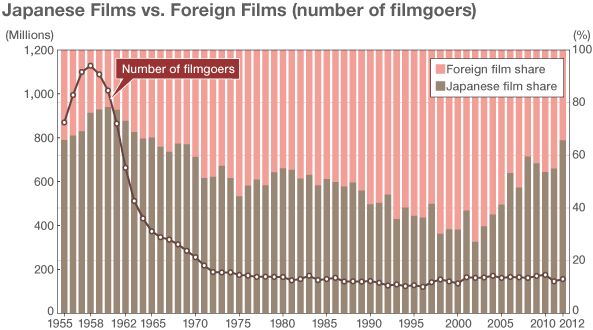
Japanese Cinema Turns the Tables on Hollywood
Economy Culture- English
- 日本語
- 简体字
- 繁體字
- Français
- Español
- العربية
- Русский
Japanese Cinema on Top Again
At the outset of the 1970s, Japanese moviegoers began to turn in increasing numbers to foreign films—particularly those from the United States and other Western nations. For decades those films enjoyed a leading share of the Japanese film market. If we look at the statistics of the Motion Picture Producers Association of Japan, which date back to 1955, we can see that during the “golden age of Japanese cinema,” between 1955 and 1965, films produced in Japan enjoyed as high as a 78% share of the domestic market. But this share steadily declined in subsequent years, hitting a low of 27.1% in 2002.
In recent years, however, the Japanese film industry has managed to claw back more and more audience share. In fact, the latest figures, for 2012, show that Japanese films now have a decisive majority of 65.7% for the domestic market, almost double the share of foreign films. The last time that Japanese films cleared the 60% mark was in 1969—over 40 years ago.

According to the MPPAJ statistics, a total of 983 films were released in 2012—a large increase over the previous year. The number of Japanese films, in particular, has increased substantially. In terms of sheer numbers, Japanese films are showing signs of pulling away from foreign films. In 2012, box-office revenue for Japanese films was roughly double that of foreign films and Japanese film revenue was 28.8% higher than the previous year—setting a new record for a year-on-year increase. In contrast, that same year revenue for foreign films shown in Japan declined by 17.9%
National Film Statistics for 2012
| 2012 | Change compared to 2011 | 2011 | ||
|---|---|---|---|---|
| Filmgoers | 155.16 million | 107.2% | 144.73 million | |
| Box-office revenue | Total | ¥195 billion | 107.7% | ¥181 billion |
| Japanese films | ¥128 billion | 128.8% | ¥99.5 billion | |
| Western films | ¥67.0 billion | 82.1% | ¥81.6 billion | |
| Number of films released | Total | 983 | 123.03% | 799 |
| Japanese | 554 | 125.62% | 441 | |
| Western | 429 | 119.83% | 358 | |
Source: Motion Picture Producers Association of Japan
Lackluster Fare from Hollywood
The 65.7% market share in 2012 for Japanese films is over 10 percentage points higher than the 54.9% of the previous year. This remarkable increase was due not only to the strength of Japanese films but also to the recent stagnation of Hollywood films.
Box-Office Revenue for Foreign Films: Top Five in 2012
| Ranking | Release month | Film name | Box-office revenue | Distributor |
|---|---|---|---|---|
| 1 | December (2011) | Mission Impossible: Ghost Protocol | ¥5.38 billion | Paramount Pictures |
| 2 | September | Resident Evil: Retribution | ¥3.81 billion | Sony Pictures |
| 3 | August | The Avengers | ¥3.61 billion | Walt Disney Studios |
| 4 | June | Amazing Spider-Man | ¥3.16 billion | Sony Pictures |
| 5 | May | Men in Black 3 | ¥3.13 billion | Tōhō-Tōwa |
If we look at the top-grossing foreign films in Japan for 2012, the box-office champ was Mission Impossible: Ghost Protocol, followed by Resident Evil: Retribution. These two films are sequels, as are the foreign films that ranked fourth and fifth for the same year. These are the sort of films that get produced because they are the safe option—almost guaranteed to be hits. The film that ranked third, The Avengers, is yet another superhero action movie, based on a Marvel Comics series. The only distinguishing feature of these films is the level of their special effects, but this is something that quickly gets old.
These top-ranked films seem to lack a distinctive concept, and this is true of recent Hollywood films in general. These films are a far cry from the 1998 film Titanic, which grossed ¥26.2 billion at the box office to become Japan’s all-time top-grossing foreign film. James Cameron, the director, used the latest special effects to tell the tale of that ill-fated ship, while painting a vivid picture of blighted love, reminiscent of Shakespeare’s Romeo and Juliet.
These days it is hard to find a similar work of genius with the power to captivate audiences. And even the supply of “safe options” has dwindled now that popular series like Harry Potter and the Pirates of the Caribbean films have reached their end.
All-time, Top-grossing Films in Japan
| Rank | Release year | Title | Box-office revenue | Distributor |
|---|---|---|---|---|
| 1 | 2001 | Spirited Away | ¥30.4 billion | Tōhō Co., Ltd. |
| 2 | 1998 | Titanic | ¥26.2 billion | Twentieth Century Fox Film Corporation |
| 3 | 2001 | Harry Potter and the Philosopher’s Stone | ¥20.3 billion | Warner Bros. Entertainment Inc. |
Wider Collaboration Behind Japanese Success
So which Japanese films edged out their Western counterparts in 2012? According to the statistics, the top three were Limit of Love: Umizaru, Thermae Romae, and Odoru daisōsasen za fainaru aratanaru kibō (Bayside Shakedown: The Final—A New Hope). All three were produced by Fuji Television and distributed by Tōhō Company.
Box-Office Revenue for Japanese Films: Top Five in 2012
| Rank | Release month | Title | Box-office revenue | Distributor |
|---|---|---|---|---|
| 1 | July | Limit of Love: Umizaru | ¥7.33 billion | Tōhō Co., Ltd. |
| 2 | April | Thermae Romae | ¥5.98 billion | Tōhō Co., Ltd. |
| 3 | September | Bayside Shakedown: The Final—A New Hope | ¥5.97 billion | Tōhō Co., Ltd. |
| 4 | November | Evangelion: 3.0 You Can (Not) Redo | ¥5.30 billion | T-Joy & Khara |
| 5 | July | Wolf Children | ¥4.22 billion | Tōhō Co., Ltd.Toho |
One element underlying the recent success of Japanese films seems to be the increasingly close collaboration between distributors and commercial television networks in Japan. An executive at the studio Tōhō explains more about this recent phenomenon:
“There is more investment in Japanese cinema these days thanks to the involvement of television networks, publishers, advertisement agencies and other businesses. This has made it possible for us to domestically produce the kind of films that people want to see. We are also doing a better job of coming up with concepts that are well suited to viewer interests. The joint investment from television networks and publishers has brought the added benefit of opportunities to more widely promote films; this has been a key factor behind box-office hits.”
The collaboration between film companies and television networks extends beyond simple examples of adapting popular television dramas to the big screen; both sides are also teaming up, from the early planning stages, to come up with cutting-edge productions. This partnership has made it possible to create the sort of historical dramas and science-fiction films that had been too expensive to produce in the past.
Foreign films may be set for a revival in Japan, though. Films shown in 2013, like Les Miserables and Life of Pi, seem to represent a return to form. If this is indeed the beginning of a comeback, Japanese filmgoers may be in for a thrilling ride.
(Originally written in Japanese.)
Films shown above:
Brave Hearts Umizaru (standard edition DVD; currently on sale)
Selling sgency: Fuji Television, Robot, Pony Canyon, Tōhō, Shōgakukan, A-Team, FNS 27
Distributor: Pony Canyon
Termae Romae Deluxe Edition (special two-disc DVD set; currently on sale)
Selling agency: Fuji Television
Distributor: Tōhō
Odoru daisōsasen za fainaru aratanaru kibō (standard edition DVD; currently on sale)
Selling agency: Fuji Television, INP
Distributor: Pony Canyon
movie culture film cinema Spirited Away Cannes Film Festival


